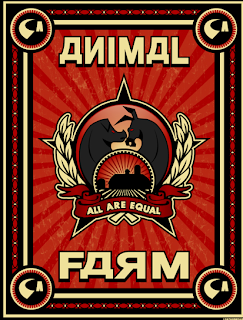
How does Orwell use the different characters and structure of the book to portray the corruption of ideals in Animal Farm?
Orwell originally titled the novel ‘Animal Farm: A Fairy Story‘. It can also be described as a fable as it is a morality tale where animals act out a human drama with a lesson to be learned. What’s interesting about Orwell’s novel is that although he uses anthropomorphism, he clearly says these animals are not human. ‘Animalism‘ is set up in opposition to the ‘enemy‘ man, and Old Major exhorts them to ‘work night and day for the overthrow of man.’ ‘Fairy Story’ has connotations of happy endings and childhood. The ending here, is far from happy making the ‘Fairy Story‘ element ironic – as if Communism was a fairy tale of ideals only children would be stupid enough to believe – like Boxer, who is loyal but ‘not of first rate intelligence‘. Like most ideals, it’s noble in the abstract, as symbolised by Old Major and Snowball, the ‘quick‘ ‘inventive‘ pig; but is ultimately crushed by Napoleon who seeks total power. It is a dramatisation of Dahlberg’s famous saying: power corrupts, absolute power corrupts absolutely. Animal Farm is an exploration of the problem of power, and the resulting suffering that comes with the total corruption of the Animals’, and Communist, ideals.
Within the novel, each character represents a figure, or group from Russian History from the start of the Revolution in 1917, moving from the ‘invention’ of Communism by Karl Marx, through Lenin to the reign of terror of Josef Stalin after he removes Trotsky. At the time of writing, Orwell wasn’t to know how, exactly, or the exact scale of the atrocities Stalin committed, which even now are uncertain. To put it in context, Hitler killed 8 million Jews. 24 million Russians, roughly died in World War II, soldiers and civilians, some killed fighting, some by Hitler and some by Stalin. Stalin himself, is estimated to have executed 20 million Russians (a small proportion of which are included in the WWII total).
Animal Farm is often described as a ‘satirical allegory’: Orwell uses the animals to represent the different sections of the Russian population from the ‘too drunk‘ Tsar, Nicholas II (Mr Jones) and his ‘snoring‘ wife, the aristocracy with their ‘ribbons’ (Mollie) and a vested interest in the system who ultimately defects. Her main interest is luxury. Her first question to the leaders is ‘Will there be sugar after the revolution?’ When there is hard work to be done, she disappears and later defects completely, as many Russian aristocrats did. Moses, the tame raven, who tells of ‘Sugarcandy Mountain‘ represents the Church. He is linked to the aristocracy as he has ‘bread soaked in beer‘ and is Mr Jones’ especial pet – in a different class to the others. When the animals run into trouble, Moses returns: when life on earth is so bad, they look to a better future life. This dramatises Karl Marx’s most famous sayings: ‘religion is the opium [drug] of the people‘. In other words, religion is a drug, needed when life is painful, but it also stops them seeking change.
Without question, Orwell shows that revolution was inevitable, and takes a positive attitude to the initial high ideals, giving Old Major a powerful piece of rhetoric, echoing the heavyweight political philosopher, Jean Jacques Rousseau‘s words when he declaims that their lives are ‘miserable, laborious and short‘. In addition, he represents Karl Marx, as the founder of Communism.
Read more in Part TWO, coming soon…
